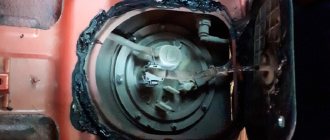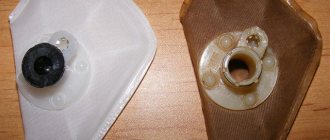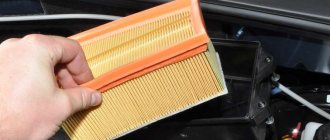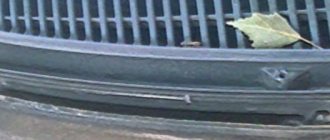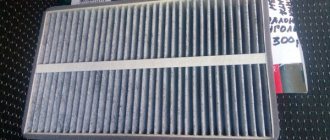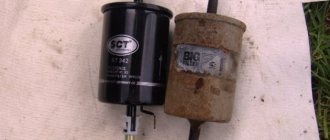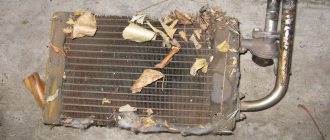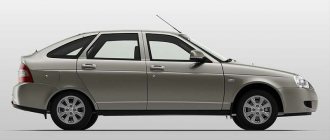Based on the characteristics of the smell that enters the vehicle interior from outside, one can judge whether the filter is worn out. In the case where this part has not been replaced for a long period, it will be a source of a not very pleasant aroma. This is due to the accumulation of waste. The service life of the cabin filter is indicated in the instructions. On average, it should be changed after 10 - 20 thousand mileage. It is worth considering that the manufacturer indicates the service life under normal conditions. The period of suitability will be halved if the transport is operated in a metropolis and the person spends a lot of time in traffic jams.
To the exact address
You can find many products on the market that look good and have an attractive price. Many buyers make their choice based on the appearance of the product and its low price. But there is a huge distance between the appearance and the quality of operation of the cabin filter. Sometimes you just want to wonder: is such a filter even capable of fulfilling its duties?
There is a simple rule that can suggest the right choice. On a high-quality filter, the country of production must be indicated: made in... You can find products that mimic Japanese or German ones, but have nothing in common with them, and only because the country of origin is not indicated. The rule is this: if you can’t find out where the filter was made, don’t buy it without regret!
How to replace the cabin filter
The easiest way to replace the cabin filter is when it is located near the engine compartment. The replacement procedure is performed as follows:
- Open the hood of the car, this will give you access to the front panel (not for all models).
- Further actions may vary. For example, some cars have a removable panel or hatch, and in order to get to the filter compartment, you need to remove this hatch. But most often you can get to the filter through the space between the windshield and the engine compartment. There is a shield that must be carefully removed, and then we will gain access to the filter compartment. The method of fastening the shield can also be different, for example, sometimes there are sealing profiles fixed with bolts.
- You can now release the cartridge. Typically, latches are used to secure it; carefully push them aside and the filter will snap off. In the future, you will have to act differently, since it depends on the developer’s imagination. Sometimes you have to slide it up to get the element out, and on some cars it just comes out straight out. The filter element can be solid, but it also happens that it consists of several parts. Be sure to remember how the cartridge is correctly positioned in the compartment; this is necessary in order to correctly install a new filter in the future.
- On many models, the cabin filter is located in the cabin, under the glove compartment or passenger seat, for example. Then there is no point in going under the hood.
The process of replacing the cabin filter on Lada Vesta - Some car versions have a dust sensor, so remove the filter carefully, otherwise the sensor may be damaged.
- Vacuum the place where the filter is attached well, and use a rag to completely remove dirt.
- Carefully and slowly insert the new filter element. Sometimes the filter may not work, do not try to use force, this often happens due to a mismatch of the filter. If you continue to push it further, you may break all the fasteners in the cell. Sometimes it’s worth paying attention to the marks; maybe you’re just not inserting it correctly.
- After the new filter is installed, you can begin assembly, but only in reverse order.
If you want to watch and understand even better how to replace the cabin filter, you can watch this video:
The smell has nothing to do with it
There is an opinion that activated carbon in the cabin filter is only needed to absorb odors. This is true, but only partly. In fact, the absorption of odors is a side effect, a free bonus if you will.
The main task is not to allow nitrogen oxides (which, by the way, caused a Volkswagen fire at the diesel gate), ozone, carbon monoxide and sulfur dioxide to enter the cabin. These are substances that are very harmful to human health, which the filter is actually supposed to absorb - it is them, and not some odors. Therefore, assessing the performance of a filter by whether it allows odors to pass through or not is incorrect.
Filter types
For the first time, air purification elements began to be installed on cars in the early 90s. At that time, if not identical, they were very similar to standard filters. Subsequently, the structure and design of the component was significantly altered and improved. The first two-layer options appeared: the first layer retained street dust, and the second eliminated the penetration of microscopic particles of pollution into the cabin. After some time, models began to appear on the market equipped with an additional layer of activated carbon, which significantly improved the quality of air filtration .
Conventionally, modern filters are divided according to the method of cleaning the air supplied to the cabin. There are 2 broad categories:
- mechanical;
- adsorption (carbon).
In the first case, the air overcomes an “obstacle” in the form of a mesh of very thin special fibers. In the second, activated carbon is included in the work, so the element additionally absorbs harmful substances and unpleasant odors.
How much does comprehensive body protection cost?
Such a high-tech filter costs about 800–900 rubles. Expensive? How to say. We breathe every day. If we divide the price of a filter by the number of days in a year—filters must be changed at least once a year—we get clean air for 2.3 rubles per day. And this is the price of health! For just over two rubles, you will rid your body of such harmful substances from roads and streets as the aforementioned nitrogen oxides, ozone, carbon monoxide and sulfur dioxide, as well as carcinogens, soot and even microscopic particles of rubber dust swirling over the asphalt.
Cabin filters for increased comfort and health protection
Bosch FILTER + cabin filters with a special combination of filter layers with activated carbon reliably absorb harmful and foul-smelling gases and filter the air efficiently, separating pollen and fine dust. Apart from this, they also provide additional protection for allergy sufferers. Each filter has a special layer that neutralizes bacteria and allergens. Moreover, such a filter effectively separates even fine dust less than 2.5 microns in size, which reduces the number of allergic reactions such as sneezing, irritation, redness and tearing of the eyes, especially during the flowering period. At the same time, Bosch cabin filters reduce the amount of deposits in the air conditioning system, thereby maintaining its efficient operation.
How to choose a quality filter?
The filter's dust transmission coefficient should be no more than 1%, but in practice many high-quality filters cope with this task even better, passing 0.5% of dust or less. Since the filter is in contact with external air, and therefore with the water vapor, fuel, and gases contained in it, it is important that the material from which it is made is strong enough, does not get wet, stick together or deform. The filter must withstand high temperatures without risk of fire. And of course, the accuracy of compliance with the air filter dimensions specified for a specific model, the reliability of connections and the quality of sealing materials are very important. For example, Bosch filters use flexible and elastic polyurethane seals to ensure better tightness and precise fit.
Some car enthusiasts, in an attempt to save money, prefer to buy the most affordable air filters, and try to compensate for low quality by more frequent replacement. But cheap filters often have significant drawbacks - low quality filter paper and a small working surface area (due to the small number of corrugations). And their increased frequency of replacement cannot be corrected in any way, so it is better to immediately buy a high-quality air filter that will not only last longer, but also provide truly reliable protection.
Video “Replacing the cabin filter of a Priora with air conditioning”
We invite you to watch a video on how to replace the cabin filter of a Priora with air conditioning. The author of INVENMEN YURIY will also share a little secret with you.
Do you have any questions? Specialists and readers of the AUTODVIG website will help you ask a question
Was this article helpful?
Thank you for your opinion!
The article was useful. Please share the information with your friends.
Yes (100.00%)
No
X
Please write what is wrong and leave recommendations on the article
Cancel reply
Rate this article: ( 5 votes, average: 5.00 out of 5)
Discuss the article:
Replacing the air filter
Replacing the air filter is not particularly difficult; you can easily do this work yourself using simple tools. You will need to study the instructions for the car, which indicate where such a cabin filter is located. Next, open the casing, usually it is secured with clips, after which they carefully remove the filter, install a new filter element in its place and snap the casing into place. Typically, such work takes no more than 5 minutes; the car does not need to be driven by a service center, which allows the car owner to save some money.
Let's sum it up
The car owner needs to regularly replace the air filter, which prevents the appearance of a characteristic unpleasant odor in the car interior and eliminates malfunctions of the air conditioner and ventilation system. Typically, such a cabin filter replacement is performed every 20,000 kilometers; you can do all the work yourself, saving on contacting specialists.
The cabin filter in a car is changed every 20,000 kilometers, but if the car is used on unpaved country roads, this service interval is reduced to 10,000.
What is smog? What are its types?
There are two types of smog.
- Classic smog, also called London smog or sour smog. Occurs during the winter season, usually from November to February (depending on weather conditions) and is closely related to the heating season. Found in cities in calm weather and fog. The reason for this is the accumulation of pollutants in the air from coal and oil furnaces. An additional reason for its formation is the combustion of pollutants in furnaces. Pollutants emitted from furnaces include fumes from cars, buses and trucks.
- Photochemical smog appears in large cities, on hot and sunny days, at temperatures above 25 °C. Photochemical smog is caused by reactions of accumulated exhaust gases with strong sunlight.
Replacing the Old Cabin Filter
Additional causes of classic and photochemical smog include:
- Accumulation of vehicular traffic in city centers caused by too little street capacity in relation to needs.
- There are too few bypass roads to allow most transit traffic to exit the city limits.
- Poor spatial planning of cities, which caused blockages in air ducts through which smog could naturally escape.
- Geographical location, such as a city located in a valley surrounded by hills, obstructs the flow of air.
- Drivers removing exhaust system components such as three-way catalytic converters in gasoline-powered vehicles, as well as DPF catalytic converters and particulate filters, resulting in increased emissions of dust and toxic substances into the atmosphere.
What harm does smog bring? In recent years, toxic nitrogen oxides, which are primarily dangerous in the presence of photochemical smog, have been primarily mentioned. It is worth remembering that cars and all transport are responsible for only 5% of the world's nitrogen oxide emissions. 95% is the influence of volcanoes, bacteria or electrical discharges. However, nitrogen oxides accumulate in cities, making them even 100 times higher than in other areas. In addition, smog contains polycyclic aromatic hydrocarbons, sulfur oxides, lead, mercury, cadmium, carbon oxides, soot (called particulate matter), pollen, sand, dust, ash, ozone and carbon dioxide.
Large dirt and leaves on the cabin filter - how to deal with it
Most cities have stations that constantly check air conditions. There are also special standards. According to the Ministry of Environment regulation, the permissible average daily limit for particulate matter emissions is 50 micrograms per cubic meter. Exceeding this dose by six times means you need to limit your exposure to air.
So what do drivers do to protect themselves from smog? Use good quality air filters and replace the cabin filter as often as possible, because this is a direct way to improve the air quality inside the car!
Where is the cabin air filter located in the car?
The location of the cabin filter depends on the design of the vehicle. On older cars, this element is mainly installed in the module where the heater motor is located. For example, a car of the SAMARA family will be equipped with a cabin filter, which is located in the engine compartment behind the partition of the engine compartment under the windshield.
In more modern cars, this adapter is installed either in one of the walls of the glove compartment or under the dashboard. More accurate information regarding a specific car can be obtained from the owner's manual for the car.
Introduction
Any vehicle consists of many components, and one part of the units is ready to actively function for more than one year, while other elements of the device must be regularly changed to ensure the overall performance of the car. For example, a device such as a cabin filter is designed to clean the air that enters the car interior through the heating system. Many motorists do not know how often to change the cabin filter in a car, although service center specialists consider replacing this type of element an integral part of any technical work. A car equipped, for example, with a charcoal device “protects” the driver and passengers from unpleasant odors coming from the street. Therefore, the unit, which absorbs dust and dirt, must be changed regularly. Let's consider the reasons and frequency of replacing cabin filters in cars.
Experts and experienced motorists recommend replacing the cabin filter once a season.


